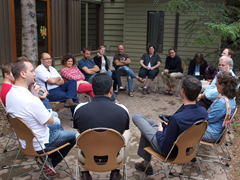Sustainability-driven Collaboration: A platform for turning wicked problems into wicked opportunities
 The article Sustainability-driven Collaboration: A platform for turning wicked problems into wicked opportunities written by Chad Park, Executive Director of The Natural Step Canada, is the first blog as part of a series that was originally published on the Social Innovation Generation website.
The article Sustainability-driven Collaboration: A platform for turning wicked problems into wicked opportunities written by Chad Park, Executive Director of The Natural Step Canada, is the first blog as part of a series that was originally published on the Social Innovation Generation website.
***
This series of posts, entitled Sustainability-driven Collaboration builds on lessons learned over years of sustainability-driven transformational change efforts at the organization level and explores the value they can bring to multi-stakeholder collaboration.
In their March 2013 post to the Harvard Business Review Blog, Paul Ellingstad and Charmian Love pointedly asked the question, Is Collaboration the new Greenwashing? This attention-grabbing title resonates strongly because of the ubiquitous use of the term collaboration in the past few years, particularly with the rise of concepts such as “Shared Value” in the business community and “Collective Impact” in the not-for-profit world. Those of us who have worked in the sustainability and social change space for some time are well aware of how easily means can be confused for ends, how often talk has been confused for action, and the difficulty of achieving transformational rather than incremental improvements.
But as Ellingstad and Love’s article points out, “to solve the big challenges in the world today we need to aim for nothing less than breakthrough levels of innovation.” At Brainstorm Green 2013, Nike’s Hanna Jones echoed this sentiment in an oft-retweeted statement: “If we don’t achieve system change, we might as well go home.” It is clear that none of us alone, working isolated in our own organizations on our own problems, can affect this change.
The need for collaboration to enable systems change is so evident and compelling that collaboration itself has become a buzzword and risks being confused for an end unto itself. How do we avoid this?
This is the real question, which Ellingstad and Love began to address in their article. How can collaboration not be the new greenwashing? How can collaborative efforts achieve breakthrough results?
Systems Change & Collaboration
 The answer requires us to understand how complex systems work and how they change. Here we turn to Donella Meadows’ classic article Leverage Points: Places to Intervene in a System and her book Thinking in Systems, which describe 12 leverage points as the most effective places to intervene in systems. Volans’ Breakthrough Business Leaders, Market Revolutions Report, released in March 2013, takes the original list of twelve and groups them into six, but generally follows Meadows’ model.
The answer requires us to understand how complex systems work and how they change. Here we turn to Donella Meadows’ classic article Leverage Points: Places to Intervene in a System and her book Thinking in Systems, which describe 12 leverage points as the most effective places to intervene in systems. Volans’ Breakthrough Business Leaders, Market Revolutions Report, released in March 2013, takes the original list of twelve and groups them into six, but generally follows Meadows’ model.
The list of system leverage points, or places to intervene in a system are as follows, in order of ascending influence:
- Changing the numbers: subsidies, taxes and standards
- Changing buffers, stocks, flows, delays and feedback loops
- Changing information flows
- Changing the rules
- Changing the system’s genetic code (or changing the purpose/goal of the system)
- Changing paradigms
Changes to higher order items on the list – rules that govern a system, the purpose that drives the system, and the paradigms making up its foundation – offer the most far-reaching and fundamental transformational change. Still, the most common methods of attempting to influence complex systems – changing numbers via subsidies, taxes and standards – while noble pursuits, unfortunately target the least effective points of leverage to affect change.
This isn’t surprising. How does one organization change the rules of a system or the system’s goals? Imagine, for example, trying to shift the rules of the transportation system of a large metropolitan area. It’s simply not something within reach of a single organization. Getting at such higher yield leverage points requires collaboration among organizations.
 In their book The Necessary Revolution: How Organizations are Collaborating to Change the World, authors Peter Senge, Bryan Smith, Nina Kruschwitz, Joe Laur, and Sara Schley recount a number of examples of successful collaboration resulting in real change. One of the most powerful examples is the story of the U.S. Green Building Council (USGBC) and the Leadership in Energy and Environmental Design (LEED) certification system, where a collaborative effort among a range of stakeholders resulted in a de facto industry standard that has managed to influence building construction by causing change to the rules of that system.
In their book The Necessary Revolution: How Organizations are Collaborating to Change the World, authors Peter Senge, Bryan Smith, Nina Kruschwitz, Joe Laur, and Sara Schley recount a number of examples of successful collaboration resulting in real change. One of the most powerful examples is the story of the U.S. Green Building Council (USGBC) and the Leadership in Energy and Environmental Design (LEED) certification system, where a collaborative effort among a range of stakeholders resulted in a de facto industry standard that has managed to influence building construction by causing change to the rules of that system.
The Necessary Revolution describes organizations that were able to find common ground, putting the issue in the centre of their efforts, and creating real and lasting change in a wide range of ways. However, as Senge and his co-authors point out, “successful collaboration is easier to espouse than achieve, and many of these efforts have struggled to realize their founders’ goals.” As anyone who has been involved in such a venture knows, collaboration is often unsuccessful, and won’t necessarily lead to systems change. Some of the most common obstacles to effective collaboration involve challenges related to trust, competing interests, power dynamics, ego, time, resources, leadership and collaborative capacity.
In recent years we’ve witnessed the rise of numerous approaches to multi-stakeholder collaboration, including some that target these key obstacles directly. Social innovation labs, including Change Labs, Design Labs, Solutions Labs and other such processes, are an important example. How can more collaborative initiatives be designed to change systems in profound, “breakthrough” ways that alter the paradigms, goals, and rules in a system and that endure over time, instead of just becoming new venues for incrementalism or distractions from deep innovation? How do we provide a platform for sustainability-driven collaboration in which participants are able to embrace complexity, and reframe ‘wicked problems’ as ‘wicked opportunities’?
In the second entry of this three-part series I will explore how lessons learned (by The Natural Step and others) from sustainability-driven change at the level of organizations may apply to the context of multi-stakeholder collaborative efforts. These lessons have underpinned the development of The Natural Step’s Sustainability Transition Lab approach.
Source: www.sigeneration.ca
Want to engage further in the conversation about sustainability-driven collaboration? The Natural Step Canada is excited to host the 2nd annual Accelerate: Collaborating for Sustainability Conference on June 5-6, 2014, in Toronto. Join us to deepen learning about collaboration from experts and practitioners, experience collaboration by creating connections with other change agents, and seed new collaborative initiatives. Learn more and register today!
- Log in to post comments

